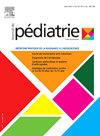青少年经期问题
Q4 Medicine
引用次数: 0
摘要
平均在12.5岁时出现第一次月经,是女孩青春期的一个显著特征。性腺向轴不成熟,这一时期的特征,导致排卵功能障碍和不规则的月经周期在月经的前5年。这种排卵功能障碍发生在55% - 82%的绝经后患者中,是与黄体酮缺乏相关的大出血或闭经障碍的原因。然而,其他病因,如止血障碍、子宫内膜异位症、卵巢囊肿或子宫畸形,不应被忽视。这些疾病对生活质量和缺勤的影响是显著的。因此,仔细的询问和临床检查将有助于寻找潜在的病理,评估身体和精神层面的影响,并提出适当的治疗建议。闭经小学,没有规则所规定的年龄为15岁,还是3年后开始中学青春期闭经以及缺乏规则定义的3个月,必须始终以严谨的方式来探索寻求pubertaire病理学,以免影响发展和生育力。Menarche,发生在平均12.5岁,是女孩青春期的一个重要事件。性腺向轴的不成熟,是这一时期的特征,是月经前5年排卵功能障碍和不规则周期的原因。这种排卵功能障碍发生在55 - 82%的少女在月经后,导致严重出血或月经障碍由于黄体酮缺乏。然而,其他病因如止血障碍、子宫内膜异位症、卵巢囊肿或子宫畸形不应被忽视。这些疾病对生活质量和缺勤的影响是值得注意的。有必要进行深入的访谈和临床检查,以寻找潜在的病理,评估身体和心理影响,并提出适当的治疗护理。原发性闭经,定义为青春期开始后15或3年没有月经,继发性闭经,定义为3个月没有月经,应始终严格调查,以确定任何可能影响青春期发育和生育的病理。本文章由计算机程序翻译,如有差异,请以英文原文为准。
Trouble des règles de l’adolescente : conduite à tenir
L’apparition des premières règles, en moyenne à l’âge de 12,5 ans, constitue un élément marquant de l’adolescence chez la jeune fille. L’immaturité de l’axe gonadotrope, caractéristique de cette période est à l’origine d’une dysfonction ovulatoire et de cycles irréguliers durant les 5 premières années de règles. Cette dysfonction ovulatoire présente chez 55 à 82 % des patientes après la ménarche est à l’origine de saignements abondants ou de dysménorrhées en lien avec une carence en progestérone. Cependant, une autre étiologie tel qu’un trouble de l’hémostase, une endométriose, un kyste ovarien ou une malformation utérine ne doit pas être méconnue. L’impact sur la qualité de vie et sur l’absentéisme scolaire de ces troubles est notable. Un interrogatoire et un examen clinique attentif permettront donc de rechercher une pathologie sous-jacente, d’évaluer le retentissement tant sur le plan somatique que psychique et de proposer une prise en charge thérapeutique adaptée. L’aménorrhée primaire, définie par l’absence de règle à l’âge de 15 ans ou bien 3 ans après le démarrage de la puberté ainsi que l’aménorrhée secondaire définie par une absence de règle pendant 3 mois, doivent toujours être explorées de façon rigoureuse afin de rechercher une pathologie susceptible d’altérer le développement pubertaire et la fertilité.
Menarche, occurring on average at the age of 12.5 years constitutes an important event during girls’ adolescence. The immaturity of the gonadotropic axis, characteristic of this period, is the cause of ovulatory dysfunction and irregular cycles during the first 5 years of menstruation. This ovulatory dysfonction is present in 55 to 82% of adolescent girls after menarche leading to heavy bleeding or dysmenorrhea due to progesterone deficiency. However, other etiologies such as a hemostatic disorder, endometriosis, an ovarian cyst, or uterine malformation should not be overlooked. The impact on the quality of life and school absenteeism due to these disorders is noteworthy. An in-depth interview and clinical examination are necessary to search for an underlying pathology, assess the somatic and psychological impact and propose appropriate therapeutic care. Primary amenorrhea, defined by the absence of menstruation at the age of 15 or 3 years after the onset of puberty, and secondary amenorrhea, defined by an absence of menstruation for 3 months, should always be rigorously investigated to identify any pathology that could affect pubertal development and fertility.
求助全文
通过发布文献求助,成功后即可免费获取论文全文。
去求助
来源期刊

Journal de Pediatrie et de Puericulture
Medicine-Pediatrics, Perinatology and Child Health
CiteScore
0.10
自引率
0.00%
发文量
53
期刊介绍:
Les articles du Journal de pédiatrie et de puériculture traitent en profondeur tous les aspects des soins à enfant dont la diversité est à image de ces professions aux rôles multiples. Les sujets traités couvrent le traitement et les soins aux enfants malades, le conseil génétique, ainsi que les techniques de pointe : nouvelles approches du diagnostic prénatal, génie génétique, etc. Les disciplines concernées sont nombreuses : pédiatrie générale, médecine fœtale et néonatale, nutrition, dermatologie, pharmacologie, psychiatrie et psychologie, puériculture pratique, enfant et société, nouvelles des congrès.
 求助内容:
求助内容: 应助结果提醒方式:
应助结果提醒方式:


